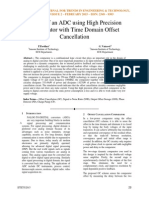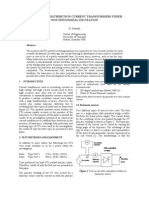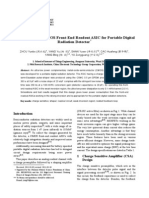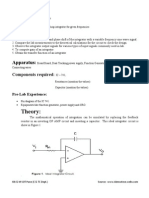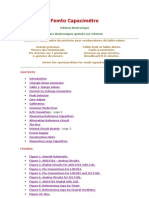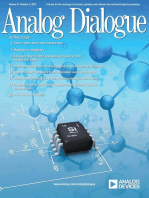Current-Transformer Phase-Shift Compensation and Calibration
Current-Transformer Phase-Shift Compensation and Calibration
Uploaded by
rsrtnjCopyright:
Available Formats
Current-Transformer Phase-Shift Compensation and Calibration
Current-Transformer Phase-Shift Compensation and Calibration
Uploaded by
rsrtnjOriginal Title
Copyright
Available Formats
Share this document
Did you find this document useful?
Is this content inappropriate?
Copyright:
Available Formats
Current-Transformer Phase-Shift Compensation and Calibration
Current-Transformer Phase-Shift Compensation and Calibration
Uploaded by
rsrtnjCopyright:
Available Formats
Application Report
SLAA122 February 2001
Current-Transformer Phase-Shift Compensation and Calibration
Kes Tam
ABSTRACT This application report demonstrates a digital technique to compensate and calibrate the phase shift of a current (or voltage) transformer used in electric power or energy measurement. Traditional analog compensation is replaced by a digital finite impulse response (FIR) filter. A technique emulating a non-unity power factor (non-UPF) load makes the calibration fully automatic. The calibration time is greatly reduced and it is more accurate and consistent. Use of emulation removes the bulky expensive non-UPF load. The 16-bit RISC MSP430 mixed-signal processor from Texas Instruments is an effective means of handling the otherwise demanding computational requirements.
Mixed Signal Products
1 2
Contents Introduction .................................................................................................................................... 1 Digital Phase Shift Compensation ................................................................................................ 2 2.1 Problem Description.................................................................................................................. 2 2.2 FIR Filter ................................................................................................................................... 3 CT Calibration ................................................................................................................................ 3 3.1 Non-UPF Load Emulation ......................................................................................................... 4 3.2 Calculation of Error ................................................................................................................... 4 3.3 Setting Up the FIR Parameters Table ....................................................................................... 5 3.4 CT With Large Phase Shift........................................................................................................ 5 3.5 Variation of Mains Frequency.................................................................................................... 6 Summary ........................................................................................................................................ 6 Figures CT Phase Response ...................................................................................................................... 2
1 Introduction
Current transformers (CTs) are commonly used in electricity meters for current measurement, and to provide isolation when direct coupling is not possible. However, all CTs include an inherent phase shift that changes the power factor of its output. Inductive and capacitive loads cause the measured ac power error to increase significantly and unacceptably as the mains power factor decreases.
SLAA122
An analog RC filter is the traditional way to overcome the phase shift problem; however, RC filters are not very satisfactory because of their cost, stability issues, and the need for time consuming manual calibration. These drawbacks are overcome with digital compensation and automated calibration. This application report consists of two parts: compensation and calibration. The section on compensation describes the design of a single zero-finite impulse response (zero-FIR) filter. This filter provides a group delay to compensate for the CTs phase shift. Unfortunately, it also alters the dc gain, and this needs to be corrected. The section on calibration shows how to calculate the FIR parameters for various delays, then deals with emulating a non-UPF load, determining the non-UPF error, and locating the actual FIR parameters used.
2 Digital Phase Shift Compensation
2.1 Problem Description
Because of inductive and capacitive loading, ac mains voltage and current are sometimes out of phase, so when a CT is used, the measured current has a phase lead (or lag) over the original current.
V I I
(in)
(out)
Figure 1.
CT Phase Response
In Figure 1, the input mains current, I(in), leads the voltage, V, by and the output current, I(out) further leads I(in) by . The actual power is
P = VO I O cos
(1)
where VO is the maximum ac input voltage, IO is the maximum ac input current, and cos is the power factor. The measured power is K ( I ) IO cos( + ) P = K (V ) VO (2)
), K(I) is the scale-down factor for where K(V) is the scale-down factor for voltage ( VO = K (V ) VO ), and cos( +) is the measured power factor. Thus, the measured error is current ( IO = K ( I ) IO
Current-Transformer Phase-Shift Compensation and Calibration
SLAA122
E( m ) = 1
P cos ( + ) = 1 P cos
(3)
The error is a nonlinear function of the power factor. For a UPF load, is usually small and the error can be ignored; however, as the power factor decreases, the error becomes significant. For example, with a power factor of 0.5 and a phase shift of 1, the error is an unacceptable 3%.
2.2
FIR Filter
To overcome the problem of phase shift across the CT, the output current could be delayed by the same amount as the inherent phase shift so that both the actual and measured power factors were equal. However, this delay would probably not be a multiple of the sampling time, so the problem could not be solved simply by adding one or more sample delays. A simple way to provide fractional delay is to use a single zero-FIR filter:
y [n ] = x [n] + x [n 1]
(4)
Here x is input current, y is delayed output current, n is sampling sequence, and is delay gain. The frequency response can be derived in z-transform space from which the filters group delay, D, is the derivative of the angular response:
D=
( + cos ) 1 + 2 + 2 cos
(5)
where is the angular frequency after sampling, equal to 2 (mains frequency)/(sampling frequency) Solving equation (5) for gives:
(1 2D ) cos (1 2D )2 cos 2 + 4D(1 D ) 2(1 D )
(6)
The phase shift is actually the group delay of the angular plane. They are related by
D =
(7)
where the phase shift, , is measured in radians. To compensate for the non-unity gain of the filter, the output is multiplied by the inverse of the filter gain, which is:
A 1 = (cos + )2 + sin 2
1/ 2
(8)
For example, for an e-meter design with a sampling frequency of 995.025 Hz, an input mains -1 frequency of 50 Hz, and a CT phase shift of 1, = 0.0611975, and A = 0.944873.
3 CT Calibration
Linear calibration should be done first because it affects the CT calibration. On the other hand, CT phase shift has almost no impact on linear calibration.
Current-Transformer Phase-Shift Compensation and Calibration
SLAA122
The actual CT calibration starts by internally delaying the mains input current to emulate a nonUPF load. This is the main technique used in the whole calibration process. A small CT phase shift creates a relatively big error in this case. Errors for a range of CT delays and parameters for the corresponding compensation FIR are pre-calculated and put into tables. The error produced with the emulated non-UPF load is measured using a reference meter. The correct FIR coefficients can then be identified by a table lookup.
3.1
Non-UPF Load Emulation
Because the CT phase shift is usually small, equation (3) shows that the error is very small under UPF load. Therefore, a large capacitor or inductor would be required in order to obtain the large errors needed for an accurate calibration. The use of internal delay to emulate this non-UPF load not only removes the necessity for these expensive and bulky loads, but it also makes the calibration process automatic by requiring only a single UPF load. The delaying of current (or voltage) input is equivalent to changing the power factor so that a non-UPF load can be emulated. There is no strict requirement on the value of the emulated nonUPF loadit needs only to be big enough for accurate calibration (but not so large as to give a very small power factor). For ease of implementation, the delay can be chosen as a multiple of the sampling time. The phase delay, , is:
f( m ) f( s )
(9)
where f(m) and f(s) are the mains and sampling frequencies, respectively, and N is the number of delayed samples. The factor cos is the emulated power factor. As an example, consider a mains frequency of 50 Hz, sampled at 995.025Hz. A three-sample delay gives a phase delay of 54.27, perfectly adequate for calibration.
3.2
Calculation of Error
There are a number of ways to get a reference input from an external reference meter. The method used here is simple: the reference meter produces LED pulses with a frequency proportional to the measured energy. For example, a rate of 1600 pulses/hr for each kilowatt-hour means that 1600 pulses will be produced in one hour with a one-kilowatt load. A simple optical sensor can be used to couple the LED pulses to the meter under calibration. This method provides a very simple interface and requires only one input line. It is assumed that the meter under calibration produces LED pulses in the same manner as the reference meter. The error caused by the CT phase shift is obtained by normalizing the difference in times needed for the same number of pulses to be emitted by the reference input and the meter internal generated. This is the pulse-time error, E(P), not the error in energy or power defined by equation (3):
t ( ref ) ) t ( ref ) E ( P ) = (t (int)
(10)
Current-Transformer Phase-Shift Compensation and Calibration
SLAA122
is the modified internal pulse time (= t(int) / cos ), t(int) is the measured internal pulse where t (int)
time, and t(ref) is the reference pulse time. Note that because the external reference does not experience the internal emulated delay, it is necessary to convert the internal time back to UPF conditions by dividing by the emulated power factor.
3.3
Setting Up the FIR Parameters Table
FIR parameters for a given phase shift can be calculated using equations (6) to (8). The calculations are best done in a spreadsheet, thereby determining an entire pre-calculated table. The tolerance of the CT phase shift must be known to determine the maximum and minimum phase shift. The phase shift step is chosen so that the error due to inexact compensation remains acceptable. For example, if the step size is 0.1 and the minimum power factor is cos(60) = 0.5, the maximum error is 1 - [cos(60 + 0.1) / cos(60)] = 0.3%. Using the second definition of the phase time error in equation (10) gives:
E( P ) =
cos 1 cos ( )
(11)
To minimize the program code size and the search time, an implicit table for E(P) can be used. The errors, E(max) and E(min), corresponding to the maximum and minimum phase shift are calculated first. Then the phase-shift step-size is translated into the error step-size:
E( step ) =
E(max) E(min) Total number of steps
For each value of E(P), the actual phase shift is calculated from equation (10), and the result is used in equations (6) to (8) to give the final FIR parameters. Because E(P) can be easily calculated from E(min) and E(step), it does not need to be storedonly E(max), E(min) and E(step) are retained.
3.4
CT With Large Phase Shift
In some cases, there are CTs with relatively large inherent phase shifts. For example, high mains frequencies or low sampling frequencies increase the phase shift of even a CT with an inherently small phase shift. This is in conformity with equation (7). CTs with a large phase shift can still be compensated and calibrated provided they exhibit a mean phase shift with an acceptable range of deviation. This kind of CT can be compensated first with an FIR designed for a mean phase shift under UPF calibration. If is more than the phase delay of a single sample, then a combination of multiple and fractional sample delays can be used, the fractional delays being derived from an FIR. In that case:
= N( d ) +
(12)
where is the phase delay of a single sample (= [mains frequency]/[sampling frequency]) and N(d) is the number of delayed samples with < . The CT phase shift is then:
(13)
Current-Transformer Phase-Shift Compensation and Calibration
SLAA122
where is the original CT phase shift. Because is very small, it can be ignored in the UPF calibration. After the UPF calibration, calibration continues with the emulated non-UPF load. However, now the equivalent phase shift, , is compensated instead of the original CT phase shift, . The equivalent emulated phase delay, , for is:
(14)
where is the actual emulated phase delay added and is the mean CT phase shift. The same technique as before can now be used to calibrate .
3.5
Variation of Mains Frequency
It is important that the actual mains frequency match the frequency of calibration. Any deviation causes a calibration error on the CT phase shift. However, once calibration is completed, the FIR compensation maintains its accuracy even under different mains frequencies.
4 Summary
In general, digital techniques have an advantage over analog in terms of accuracy and consistency; however, this often comes at a higher cost. The method outlined in this application report uses digital techniques for compensating and calibrating a CT and yet is simple enough to be implemented in a low cost microcontroller. The solution has been successfully implemented in a Texas Instruments MSP430 microcontroller and has passed a national approval for class-1 electricity meters.
Bibliography
1. A Low-Cost Single-Phase Electricity Meter Using MSP430C11x, Application Report, Texas Instruments Literature Number SLAA075 2. MSP430x1xx Family Users Guide, Texas Instruments Literature Number SLAU049 3. MSP430 Family Mixed-Signal Microcontroller Application Reports, Application Book, Texas Instruments Literature Number SLAA024 4. Bureau of Indian Standards, AC Static Watt-Hour Meters, Class-1 and -2 Specification, Reference Number ET13 (1379)
Current-Transformer Phase-Shift Compensation and Calibration
IMPORTANT NOTICE Texas Instruments and its subsidiaries (TI) reserve the right to make changes to their products or to discontinue any product or service without notice, and advise customers to obtain the latest version of relevant information to verify, before placing orders, that information being relied on is current and complete. All products are sold subject to the terms and conditions of sale supplied at the time of order acknowledgment, including those pertaining to warranty, patent infringement, and limitation of liability. TI warrants performance of its products to the specifications applicable at the time of sale in accordance with TIs standard warranty. Testing and other quality control techniques are utilized to the extent TI deems necessary to support this warranty. Specific testing of all parameters of each device is not necessarily performed, except those mandated by government requirements. Customers are responsible for their applications using TI components. In order to minimize risks associated with the customers applications, adequate design and operating safeguards must be provided by the customer to minimize inherent or procedural hazards. TI assumes no liability for applications assistance or customer product design. TI does not warrant or represent that any license, either express or implied, is granted under any patent right, copyright, mask work right, or other intellectual property right of TI covering or relating to any combination, machine, or process in which such products or services might be or are used. TIs publication of information regarding any third partys products or services does not constitute TIs approval, license, warranty or endorsement thereof. Reproduction of information in TI data books or data sheets is permissible only if reproduction is without alteration and is accompanied by all associated warranties, conditions, limitations and notices. Representation or reproduction of this information with alteration voids all warranties provided for an associated TI product or service, is an unfair and deceptive business practice, and TI is not responsible nor liable for any such use. Resale of TIs products or services with statements different from or beyond the parameters stated by TI for that product or service voids all express and any implied warranties for the associated TI product or service, is an unfair and deceptive business practice, and TI is not responsible nor liable for any such use. Also see: Standard Terms and Conditions of Sale for Semiconductor Products. www.ti.com/sc/docs/stdterms.htm
Mailing Address: Texas Instruments Post Office Box 655303 Dallas, Texas 75265
Copyright 2001, Texas Instruments Incorporated
You might also like
- Biomedical Instrumentation Lab 1Document95 pagesBiomedical Instrumentation Lab 1EmirDefa50% (2)
- Study of Relay Protection On PT. PLN (PERSERO) P3B Jawa-Bali RJTB UPT KediriDocument4 pagesStudy of Relay Protection On PT. PLN (PERSERO) P3B Jawa-Bali RJTB UPT KediriMuhammad RafiNo ratings yet
- Techniques UPS: DigitalDocument6 pagesTechniques UPS: DigitalFabian Rodriguez NietoNo ratings yet
- Dual Slope AdcDocument5 pagesDual Slope AdcvishvinnyNo ratings yet
- Practical Feedback Loop Design Considerations For Switched Mode Power SuppliesDocument14 pagesPractical Feedback Loop Design Considerations For Switched Mode Power SuppliesDiego PhillipeNo ratings yet
- Design of An ADC Using High Precision Comparator With Time Domain Offset CancellationDocument4 pagesDesign of An ADC Using High Precision Comparator With Time Domain Offset CancellationijtetjournalNo ratings yet
- Ac Lab Student Manual (2015-16)Document102 pagesAc Lab Student Manual (2015-16)abhinn salujaNo ratings yet
- EthernetDocument16 pagesEthernetpascaruflorinNo ratings yet
- Optimizing The Design of A Switched-Capacitor Dynamic-Element-Matching AmplifierDocument6 pagesOptimizing The Design of A Switched-Capacitor Dynamic-Element-Matching Amplifierreza12368No ratings yet
- Fault Resistance, Location and Inception Angle Effects On DC Offset of The Fault CurrentsDocument6 pagesFault Resistance, Location and Inception Angle Effects On DC Offset of The Fault CurrentsItalo ChiarellaNo ratings yet
- New Single-Phase Active Power Filter: Idc (T)Document6 pagesNew Single-Phase Active Power Filter: Idc (T)murthy237No ratings yet
- Power Quality Impacts of An Electric Arc Furnace and Its CompensationDocument8 pagesPower Quality Impacts of An Electric Arc Furnace and Its CompensationPudhur Kannan ManiNo ratings yet
- Effects of Dynamic Fault Impedance Variation On Accuracy of Fault Location Estimation For Series Compensated Transmission LinesDocument5 pagesEffects of Dynamic Fault Impedance Variation On Accuracy of Fault Location Estimation For Series Compensated Transmission Linesjijo123408No ratings yet
- Virtual Instrument Based Fault Classification in Power Transformers Using Artificial Neural NetworksDocument5 pagesVirtual Instrument Based Fault Classification in Power Transformers Using Artificial Neural NetworksNituNo ratings yet
- Chopper Controlled DC Drive: INSTRUCTED BY: Dr. BuddhikaDocument8 pagesChopper Controlled DC Drive: INSTRUCTED BY: Dr. BuddhikaNipuna Thushara WijesekaraNo ratings yet
- Lab1 AM Modulation Demod HandoutDocument5 pagesLab1 AM Modulation Demod HandoutAshok Naik100% (1)
- Uc3842 Provides Low-Cost Current-Mode Control: Application NoteDocument16 pagesUc3842 Provides Low-Cost Current-Mode Control: Application NoteLeonardo Ortiz100% (1)
- 048 Venkatesh AUPEC01paperDocument5 pages048 Venkatesh AUPEC01paperDante FilhoNo ratings yet
- Making Accurate DC Voltage Measurements in The Presence of Series Mode AC SignalsDocument6 pagesMaking Accurate DC Voltage Measurements in The Presence of Series Mode AC SignalsRangga Kusuma NegaraNo ratings yet
- Transformer-Coupled Front-End For Wideband A/D Converters: Primary SecondaryDocument4 pagesTransformer-Coupled Front-End For Wideband A/D Converters: Primary SecondaryAvinash SharmaNo ratings yet
- EC 351 AC Analog Communication Lab ManualDocument117 pagesEC 351 AC Analog Communication Lab Manualhodibaaba1No ratings yet
- 10 ISH 2007 - Online Monitoring of A Transformer by Means of FRADocument6 pages10 ISH 2007 - Online Monitoring of A Transformer by Means of FRATrường ArsenalNo ratings yet
- Universal Digital Controller For Boost CCM Power Factor Correction Stages Based On Current Rebuilding ConceptDocument12 pagesUniversal Digital Controller For Boost CCM Power Factor Correction Stages Based On Current Rebuilding ConceptsindhukamitkarNo ratings yet
- AN3005Document4 pagesAN3005teomondoNo ratings yet
- A Low Power, and Low Signal 5-Bit 25msamples/s Pipelined ADC For Monolithic Active PixelsDocument5 pagesA Low Power, and Low Signal 5-Bit 25msamples/s Pipelined ADC For Monolithic Active Pixelstajmjcet_123No ratings yet
- AP PTC 2012 19 Teratam EnuDocument7 pagesAP PTC 2012 19 Teratam EnubcqbaoNo ratings yet
- Function Generator Op-Amp Summing Circuits Pulse Width Modulation LM311 ComparatorDocument7 pagesFunction Generator Op-Amp Summing Circuits Pulse Width Modulation LM311 ComparatorMuhammad JunaidNo ratings yet
- Es1107 Assignment-01Document6 pagesEs1107 Assignment-01K. BHANU PRAKASH REDDYNo ratings yet
- Analysis of The Behavior of One Digital Distance Relay Under Islanding Condition With ATPDocument6 pagesAnalysis of The Behavior of One Digital Distance Relay Under Islanding Condition With ATPJaime Florez ChoqueNo ratings yet
- Digital Control of A Three Phase 4 Wire PWM Inverter For PVDocument9 pagesDigital Control of A Three Phase 4 Wire PWM Inverter For PV7788778887No ratings yet
- Modelling Sigdelta Non-IdealtiesDocument5 pagesModelling Sigdelta Non-IdealtiesVivek KumarNo ratings yet
- Accuracy of Distribution Current Transformers Under Non-Sinusoideal ExcitationDocument5 pagesAccuracy of Distribution Current Transformers Under Non-Sinusoideal ExcitationAnonymous NGXdt2BxNo ratings yet
- Active Filter Compensation: Single-Phase Power For HarmonicDocument5 pagesActive Filter Compensation: Single-Phase Power For HarmonicĐỗ TrườngNo ratings yet
- DeDocument7 pagesDeSudhakar SpartanNo ratings yet
- FlyBack Transformer CalculationsDocument7 pagesFlyBack Transformer CalculationsdllabarreNo ratings yet
- Software Phase Locked LoopDocument7 pagesSoftware Phase Locked LoopBinyam YohannesNo ratings yet
- A CMOS Mixed-Signal 100 MB S Receive Architecture For Fast EthernetDocument4 pagesA CMOS Mixed-Signal 100 MB S Receive Architecture For Fast EthernetYX PNo ratings yet
- Uninterruptible Power Supply Multiloop Control Employing Digital Predictive Voltage and Current RegulatorsDocument9 pagesUninterruptible Power Supply Multiloop Control Employing Digital Predictive Voltage and Current RegulatorsPhạm Văn TưởngNo ratings yet
- A New Approach of Dead-Time Compensation For PWM Voltage InvertersDocument8 pagesA New Approach of Dead-Time Compensation For PWM Voltage Invertersshankul.saurabhNo ratings yet
- New Method of Power Swing Blocking For Digital Distance ProtectionDocument8 pagesNew Method of Power Swing Blocking For Digital Distance ProtectionJohari Zhou Hao LiNo ratings yet
- Switched Capacitor Signal Conditioning For Push-Pull Type Capacitive SensorsDocument4 pagesSwitched Capacitor Signal Conditioning For Push-Pull Type Capacitive SensorssriraghavrNo ratings yet
- Analog Signals Digital Signals Analog-To-Digital ConverterDocument39 pagesAnalog Signals Digital Signals Analog-To-Digital ConverterAishwarya SumaNo ratings yet
- The Integrating A/D Converter (ICL7135) : Application Note February 1999Document5 pagesThe Integrating A/D Converter (ICL7135) : Application Note February 1999ytnateNo ratings yet
- OFCOMP-4-2009-A 1 GHZ CMOS Comparator With Dynamic Offset Control Technique (Xiaolei Zhu1, Sanroku Tsukamoto2, and Tadahiro Kuroda1)Document2 pagesOFCOMP-4-2009-A 1 GHZ CMOS Comparator With Dynamic Offset Control Technique (Xiaolei Zhu1, Sanroku Tsukamoto2, and Tadahiro Kuroda1)savani1979No ratings yet
- Power Factor Correction AC-DC Boost Converter Using PI-hysteresis Current ControlDocument7 pagesPower Factor Correction AC-DC Boost Converter Using PI-hysteresis Current ControlInternational Journal of Power Electronics and Drive SystemsNo ratings yet
- Analog Communications Lab ManualDocument61 pagesAnalog Communications Lab ManualSriLakshmi RaheemNo ratings yet
- Pulse-Width-Modulation DC Chopper Using Labview SoftwareDocument5 pagesPulse-Width-Modulation DC Chopper Using Labview SoftwareFlorin LațcuNo ratings yet
- Experiment 3 Frequency Modulator: 1 TheoryDocument7 pagesExperiment 3 Frequency Modulator: 1 TheoryreganoctNo ratings yet
- California Eastern LaboratoriesDocument10 pagesCalifornia Eastern LaboratorieskuazuNo ratings yet
- Expt No. 03 - To Design and Test Op Amp Integrator For Given FrequenciesDocument7 pagesExpt No. 03 - To Design and Test Op Amp Integrator For Given FrequenciesPrakash Narkhede100% (1)
- Wcecs2009 - pp545-549 Computer LoadsDocument5 pagesWcecs2009 - pp545-549 Computer LoadsYogesh MsdNo ratings yet
- Capacimetre FemtoDocument30 pagesCapacimetre FemtoJean-Marie ChaputNo ratings yet
- An 563Document18 pagesAn 563RushabhShahNo ratings yet
- Power Quality Improvement of Unified Power Quality Conditioner Using Reference Signal Generation MethodDocument5 pagesPower Quality Improvement of Unified Power Quality Conditioner Using Reference Signal Generation MethodSurya Ch VenkataNo ratings yet
- A Method For ADC Error Testing and Its Compensation in Ratiometric MeasurementsDocument4 pagesA Method For ADC Error Testing and Its Compensation in Ratiometric MeasurementsPreejit PrakashNo ratings yet
- Torque Ripple Minimization for Induction Motor Drives with Direct Torque ControlDocument16 pagesTorque Ripple Minimization for Induction Motor Drives with Direct Torque Controlabdmd1231No ratings yet
- Reference Guide To Useful Electronic Circuits And Circuit Design Techniques - Part 1From EverandReference Guide To Useful Electronic Circuits And Circuit Design Techniques - Part 1Rating: 2.5 out of 5 stars2.5/5 (3)
- Reference Guide To Useful Electronic Circuits And Circuit Design Techniques - Part 2From EverandReference Guide To Useful Electronic Circuits And Circuit Design Techniques - Part 2No ratings yet
- Telugu Grammer LessonDocument17 pagesTelugu Grammer LessonrsrtnjNo ratings yet
- Computational Methods in Power System AnalysisDocument113 pagesComputational Methods in Power System Analysisrsrtnj100% (10)
- DC DC Power SuppliesDocument33 pagesDC DC Power SuppliesrsrtnjNo ratings yet
- Introduction To Electrical DrivesDocument18 pagesIntroduction To Electrical DrivesSidali Chaib50% (2)
- Nonlinear - Local ControllabilityDocument12 pagesNonlinear - Local ControllabilityrsrtnjNo ratings yet
- Ts FindDocument0 pagesTs FindrsrtnjNo ratings yet
- An Electronic Water Meter Design Using MSP430F41xDocument13 pagesAn Electronic Water Meter Design Using MSP430F41xrsrtnjNo ratings yet
- Implementing An Electronic Watt-Hour Meter With MSP430FE42x (A) /FE42x2Document32 pagesImplementing An Electronic Watt-Hour Meter With MSP430FE42x (A) /FE42x2rsrtnjNo ratings yet
- Microchip SPICE Models 01256aDocument12 pagesMicrochip SPICE Models 01256arsrtnjNo ratings yet
- CapacitorsDocument10 pagesCapacitorsrsrtnj100% (1)





